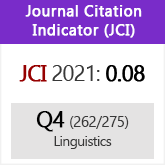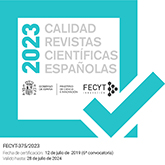Software-assisted identification of non-native pitch elements for Russian-speaking learners of Spanish
DOI:
https://doi.org/10.3989/loquens.2023.e104Keywords:
prosody, pitch, software, Spanish L2, Russian speakersAbstract
In this paper we present the results of an automatic comparative-contrastive analysis of functional elements of intonational contour (anacrusis, first peak, body, nucleus and final inflection) produced by non-native speakers of Spanish, whose first language is Russian. This analysis was carried out with the Plugin for phonetic-phonological analysis in Spanish (PAFe), a software tool for an instant comparative analysis of a non-native speakers’ pronunciation which takes audio recordings as input and implements multiple intonation comparison algorithms between native and non-native speakers of Spanish to calculate the percentage of similarity in intonation production. We used the intersyllabic analysis function of PAFe in order to identify which functional pitch elements of Russian speaking learners of Spanish -male and female- present more tonal deviations. Our results show that most tonal differences occurred in the body of the f 0 contour for female speakers whereas for male speakers the greatest tonal contrast was in the first peak. The obtained data indicate that these pitch elements are potentially challenging for Russian speaking learners of Spanish in their pursuit of acquiring phonetic-phonological competence. In addition, this study allowed us to identify which parameters of PAFe analysis per syllables require further refinement, such as processing of limited intonational spectrum values.
Downloads
References
Boersma, P., & Weenink, D. (2019). Praat: doing phonetics by computer (version 6.0. 52) [windows]. Available at: https://www.fon.hum.uva.nl/praat/.
Bryzgunova, E. A. (1977). Zvuki i intonatsiya russkoi rechi. Russkii yazyk.
Cantero-Serena, F. J. (2002). Teoría y análisis de la entonación (Vol. 54). Edicions Universitat Barcelona.
Cantero-Serena, F. J. (2019). Análisis prosódico del habla: más allá de la melodía. Comunicación Social: Lingüística, Medios Masivos, Arte, Etnología, Folclor y otras ciencias afines, 2, 485-498.
Cantero-Serena, F. J., & Mateo-Ruiz, M. (2013). La entonación prelingüística del español: implicaciones didácticas. In Aportaciones para una educación lingüística y literaria en el siglo xxi, 2-11.
Couto-Fernández, T. (2021). Una herramienta de análisis del habla de audio para proporcionar retroalimentación automática a los estudiantes en la pronunciación en español.
Couto-Fernández, T., Sarymsakova, A., Condori-Fernández, N., & Martín-Rodilla, P. (2022). Plugin for automatisation of phonetic-phonological analysis and obtaining analytical feedback for Spanish learners. In Sepln-pd 2022: Annual conference of the Spanish Association for Natural Language Processing 2022: Projects and Demonstrations, 83-87. Retrieved from https://bit.ly/48yNqz2
Dmítrieva, A. (2017). Estudio recíproco de la fonética y fonología del español y el ruso desde el punto de vista de su adquisición y de su enseñanza como lenguas extranjeras (Doctoral dissertation, Universidad Pablo de Olavide). Retrieved from https://bit.ly/47sVi3G
Elvira-García, W., Farrús, M., & Garrido-Almiñana, J. M. (2023, Jun.). Comparison of intensity-based methods for automatic speech rate computation. Loquens, 9(1-2), e090. https://doi.org/10.3989/loquens.2022.e090
Font-Rotchés, D., & Cantero-Serena, F. J. (2008). La melodía del habla: acento, ritmo y entonación. Eufonía. Didáctica de la música, 43, 19-39. Retrieved from https://bit.ly/3NYz0zF
Font-Rotchés, D., & Cantero-Serena, F. J. (2009). Melodic analysis of speech method (MAS) applied to Spanish and Catalan. Phonica, 5, 33-47.
García-Riverón, R. (1980). Sistema sobstvenno voprositel'nyj predlozhenii v sopostovlenii s ispanskim. MGU.
García-Riverón, R. (1987). La interrogación. Introducción a su estudio. Editorial Científico-Técnica.
Hidalgo-Navarro, A. (2019). Sistema y uso de la entonación en español hablado: aproximación interactivo-funcional. Ediciones Universidad Alberto Hurtado.
Kisler, T., Reichel, U., & Schiel, F. (2017). Multilingual processing of speech via web services. Computer Speech & Language, 45, 326-347. https://doi.org/10.1016/j.csl.2017.01.005
Martin-Rodilla, P., & Gonzalez-Perez, C. (2023). Same text, same discourse? Empirical validation of a discourse analysis methodology for cultural heritage. Digital Scholarship in the Humanities, 38(1), 224-239. https://doi.org/10.1093/llc/fqac038
Martin-Rodilla, P., Panach, J. I., Gonzalez-Perez, C., & Pastor, O. (2018). Assessing data analysis performance in research contexts: An experiment on accuracy, efficiency, productivity and researchers' satisfaction. Data & Knowledge Engineering, 116, 177-204. https://doi.org/10.1016/j.datak.2018.06.003
Mateo, M. (2010a). Protocolo para la extracción de datos tonales y curva estándar en análisis melódico del habla (AMH). Phonica, 6, 49-90.
Mateo, M. (2010b). Scrips en Praat para la extracción de datos tonales y curva estándar. Phonica, 6, 91-111.
Mazina, L. (1984). Методика обучения студентов-иностранцев интонации русского языка (начальный этап контакта испанского языка с русским) (Doctoral dissertation, Московский государственный педагогический институт иностранных языков имени Мори́са Торе́за). Retrieved from https://bit.ly/47tWcge
Oplustil, P., & Toledo, G. (2019). Uso de una herramienta didáctica para la práctica de la entonación en hablantes no nativos de español. 37-50. https://doi.org/10.21001/sintagma.2019.31.03
Panach, J. I., España, S., Dieste, O., Pastor, Ó., & Juristo, N. (2015). In search of evidence for model-driven development claims: An experiment on quality, effort, productivity and satisfaction. Information and software technology, 62, 164-186. https://doi.org/10.1016/j.infsof.2015.02.012
Patil, V., & Rao, P. (2012). Automatic pronunciation assessment for language learners with acoustic-phonetic features. In Proceedings of the workshop on speech and language processing tools in education, 17-24.
Pop, D.-P., & Altar, A. (2014). Designing an MVC model for rapid web application development. Procedia Engineering, 69, 1172-1179. https://doi.org/10.1016/j.proeng.2014.03.106
Rodríguez-Fernández, I., Canosa, A., Mucientes, M., & Bugarín, A. (2015). STAC: a web platform for the comparison of algorithms using statistical tests. In Proceedings of the 2015 ieee international conference on fuzzy systems (fuzz-ieee). https://doi.org/10.1109/FUZZ-IEEE.2015.7337889
Sarymsakova, A. (2022). La enseñanza del español a rusohablantes por medio de interacciones profesionales simuladas (role-play): el análisis del conflicto comunicativo e intercultural y su relación con la prosodia y el gesto (Doctoral dissertation, Universidade da Coruña). Retrieved from https://bit.ly/3kAevOf
Schiel, F. (1999). Automatic phonetic transcription of non-prompted speech. In Proceedings of the XIVth International Congress of Phonetic Sciences: ICPhS 99
San Francisco, 1-7 August 1999, San Francisco: 607-610. Retrieved from https://bit.ly/3TRkLQX
Strik, H., Truong, K., De Wet, F., & Cucchiarini, C. (2009). Comparing different approaches for automatic pronunciation error detection. Speech communication, 51(10), 845-852. https://doi.org/10.1016/j.specom.2009.05.007
Wohlin, C., Runeson, P., Höst, M., Ohlsson, M. C., Regnell, B., & Wesslén, A. (2012). Experimentation in software engineering. Springer Science & Business Media. https://doi.org/10.1007/978-3-642-29044-2
Published
How to Cite
Issue
Section
License
Copyright (c) 2023 Consejo Superior de Investigaciones Científicas (CSIC)

This work is licensed under a Creative Commons Attribution 4.0 International License.
© CSIC. Manuscripts published in both the printed and online versions of this Journal are the property of Consejo Superior de Investigaciones Científicas, and quoting this source is a requirement for any partial or full reproduction.All contents of this electronic edition, except where otherwise noted, are distributed under a “Creative Commons Attribution 4.0 International” (CC BY 4.0) License. You may read here the basic information and the legal text of the license. The indication of the CC BY 4.0 License must be expressly stated in this way when necessary.
Self-archiving in repositories, personal webpages or similar, of any version other than the published by the Editor, is not allowed.
Funding data
Ministerio de Ciencia e Innovación
Grant numbers TED2021-130295B-C33;PID2020-114758RB-I00
Agencia Estatal de Investigación
Grant numbers TED2021-130295B-C33;PID2020-114758RB-I00















